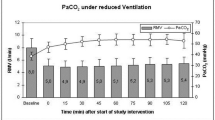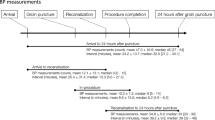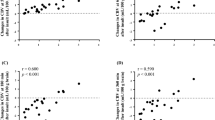Abstract
We investigated whether group B streptococcal (STREP) infusion impairs the cerebral blood flow (CBF) response to acute hypercarbia in piglets, and whether STREP-induced prostanoids or hemodynamic alterations could account for this impairment. Piglets, 2-3 wk old, were anesthetized, paralyzed, and mechanically ventilated (50% O2; partial pressure of arterial CO2 (Paco2) ≈ 40 torr). CBF was assessed by internal carotid artery blood flow (ICBF). Group 1 (n = 5) received a continuous infusion of STREP for 4 h (2.0-8.0 × 107 org/kg-min). Group 2(n = 5) was pretreated with indomethacin (5 mg/kg), then received the identical STREP infusion. Group 3 (n = 6) did not receive STREP, but cardiac output (CO) and systemic blood pressure (BP) were reduced to levels equal to that of group 1 by incremental inflation of a left atrial balloon (LAB) catheter. Cerebral vascular reactivity to acute hypercarbia(Paco2 ≈ 70 torr for 7.5 min) was assessed at baseline and after each hour of STREP infusion or LAB inflation. We found that 4 h of STREP infusion caused CO to fall significantly (634 ± 121 to 324 ± 172 mL/min, group 1; 600 ± 68 to 291 ± 80 mL/min, group 2) and BP to fall significantly (104 ± 20 to 57 ± 4 mm Hg, group 1; 91± 11 to 53 ± 16 mm Hg, group 2) By design, in group 3 LAB inflation caused CO (573 ± 181 to 375 ± 159 mL/min) and BP (104± 14 to 60 ± 9 mm Hg) to fall to values not significantly different from septic groups 1 and 2. At 4 h, unilateral ICBF decreased significantly during STREP infusion in group 1 (32.0 ± 10.8 to 21.0± 7.3 mL/min) and group 2 (22.9 ± 9.9 to 13.1 ± 4.3 mL/min), but not in nonseptic group 3 (23.1 ± 7.4 to 19.6 ± 6.3 mL/min). At baseline, hypercarbia induced an increase in ICBF (%ΔICBF = 68.7 ± 13.0% in group 1, 62.2 ± 15.6% in group 2, and 87.7± 34.0% in group 3). After 4 h of STREP, this response was completely ablated as ICBF fell during hypercarbia by -7.8 ± 23.2% (group 1). Indomethacin did not protect cerebral vascular reactivity after 4 h of STREP infusion, as%ΔICBF fell during hypercarbia by -10.9 ± 17.7%(group 2). In contrast, despite equivalent reductions in CO and BP after 4 h of LAB inflation in nonseptic group 3, ICBF rose during hypercarbia by 61.8± 23.2%, not significantly different from baseline, but significantly different from the decrease in%ΔICBF in groups 1 and 2. We conclude that STREP infusion reduces ICBF and cerebral vascular reactivity to acute hypercarbia in piglets. This phenomenon is not accounted for by STREP-induced reduction in CO or BP, and is not mediated by prostanoids.
Similar content being viewed by others
Log in or create a free account to read this content
Gain free access to this article, as well as selected content from this journal and more on nature.com
or
Abbreviations
- STREP:
-
group B Streptococcus
- CBF:
-
cerebral blood flow
- LAB:
-
left atrial ballon
- ICBF:
-
internal carotid artery blood flow
- CO:
-
cardiac output
- PA:
-
pulmonary artery
- PAP:
-
pulmonary artery pressure
- BP:
-
systemic blood pressure
- EDRF:
-
endothelium-derived relaxation factor
- CVP:
-
central venous pressure
- SSP:
-
sagittal sinus pressure
- RMANOVA:
-
repeated measures analysis of variance
- Pao2:
-
partial pressure of arterial O2
- Paco2:
-
partial pressure of arterial CO2
References
Wylam ME, Samsel RW, Umans JG, Mitchell RW, Leff AR, Schumacker PT 1990 Endotoxin in vivo impairs endothelium-dependent relaxation of canine arteries in vivo. Am Rev Respir Dis 142: 1263–1267
Nelson DP, Beyer C, Samsel RW, Wood LDH, Schumacker PT 1987 Pathological supply dependence of O2 uptake during bacteremia in dogs. J Appl Physiol 63: 1487–1492
McKenna TM, Martin FM, Chernow B, Briglia FA 1986 Vascular endothelium contributes to decreased aortic contractility in the adult respiratory distress syndrome. Circ Shock 19: 267–73
Bone RC 1994 Sepsis and its complications: the clinical problem. Crit Care Med 22:S8–S11
Bowton DL, Bertels NH, Prough DS, Stump DA 1989 Cerebral blood flow is reduced in patients with sepsis syndrome. Crit Care Med 17: 399–403
Meadow WL, Rudinsky BF, Strates E 1987 Oxygen delivery, oxygen consumption, and metabolic acidosis during GBS sepsis in piglets. Pediatr Res 22: 509–512
Runkle B, Goldberg RN, Streitfeld MM, Clark MR, Buron E, Setzer ES, Bancalari E 1984 Cardiovascular changes in group B streptococcal sepsis in the piglet: response to indomethacin and relationship to prostacyclin and thromboxane A2 . Pediatr Res 18: 874–878
Gibson RL, Truog WE, Redding GJ 1988 Thromboxane-associated pulmonary hypertension during three types of Gram-positive bacteremia in piglets. Pediatr Res 23: 553–556
Tarpey MN, Graybar GB, Lyrene RK, Gofoy G, Oliver J, Gray BM, Philips JB 1987 Thromboxane synthesis inhibition reverses group B Streptococcus-induced pulmonary hypertension. Crit Care Med 15: 644–647
Troug WE, Sorenson GK, Standaert A, Redding GJ 1986 Effects of the thromboxane inhibitor, dazemgrel (UK 38,485), on pulmonary gas exchange and hemodynamics in neonatal sepsis. Pediatr Res 20: 481–486
Leffler CW, Busija DW, Fletcher AM, Beasley DG, Hessler JR, Green RS 1985 Effects of indomethacin upon cerebral hemodynamics of newborn pigs. Pediatr Res 19: 1160–1164
Leffler CW, Busija DW 1985 Prostanoids in cortical subarachnoid cerebrospinal fluid and pial arterial diameter in newborn pigs. Circ Res 57: 689–694
Wagerle LC, Mishra OP 1988 Mechanism of CO2 response in cerebral arteries of the newborn pig: role of phospholipase, cyclooxygenase, and lipoxygenase pathways. Circ Res 62: 1019–1026
Chemtob S, Beharry K, Rex J, Varma DR, Aranda JV 1990 Prostanoids determine the range of cerebral blood flow autoregulation of newborn piglets. Stroke 21: 777–784
Rudinsky BF, Meadow WL 1992 Relationship between oxygen delivery and metabolic acidosis during sepsis in piglets. Crit Care Med 20: 831–39
Fahey JT, Lister G 1987 A simple method for reducing cardiac output in the conscious lamb. Am J Physiol 249:H188–H192
Meadow W, Rudinsky B, Bell A, Lozon M, Randle C, Hipps R 1994 The role of prostaglandins and endothelium derived relaxation factor in the regulation of cerebral blood flow and cerebral oxygen utilization in the piglet: operationalizing the concept of an essential circulation. Pediatr Res 35: 649–656
Lozon M, Rudinsky B, Randle C, Hipps R, Meadow W 1991 Effects of indomethacin on cerebral O2 regulation and cerebrovascular reactivity: in situ measurements in neonatal piglets. Pediatr Res 29: 223
Buckley NM, Gootman PM, Gootman N, Reddy GD, Weaver LC, Crane LA 1976 Age-dependent cardiovascular effects of afferent stimulation in neonatal pigs. Biol Neonate 30: 268–279
Scremin OU, Sonnenschein RR, Rubinstein EH 1982 Cerebrovascular anatomy and blood flow measurements in the rabbit. J Cereb Blood Flow Metab 2: 55–66
Scremin OU, Sonnenschein RR, Rubinstein EH 1983 Cholinergic cerebral vasodilatation: lack of involvement of cranial parasympathetic nerves. J Cereb Blood Flow Metab 3: 362–368
Kirk BW, Raber MB 1973 A practical apparatus for rapid determination of blood oxygen content. J Appl Physiol 34: 724–725
Glanz SA 1987 Primer of Biostatistics, 2nd Ed. McGraw-Hill, New York, pp 30–63
Bressack MA, Morton NS, Hortop J 1987 Group B streptococcal sepsis in the piglet: effects of fluid therapy on venous return, organ edema, and organ blood flow. Circ Res 61: 659–669
Mirro R, Leffler CW, Armstead W, Beasley DG, Busija DW 1988 Indomethacin restricts cerebral blood flow during pressure ventilation of newborn piglets. Pediatr Res 24: 59–62
Pourcyrous M, Leffler CW, Bada HS, Korones SB, Busija DW 1994 Cerebral blood flow responses to indomethacin in awake newborn piglets. Pediatr Res 35: 565–570
Hammerman C, Komar K, Meadow W, Strates E 1988 Selective inhibition of thromboxane synthase reduces group B β-hemolytic streptococci-induced pulmonary hypertension in piglets. Dev Pharmacol Ther 11: 306–312
Barefield ES, Hicks TP, Philips JB 1994 Thromboxane and pulmonary morphometry in the development of the pulmonary hypertensive response to group B Streptococcus. Crit Care Med 22: 506–514
Busija DW, Leffler CW, Wagerle LC 1990 Mono-L-arginine-containing compounds dilate piglet pial arterioles via an endothelium-derived relaxing factor-like substance. Circ Res 67: 1374–1380
Greenberg RS, Helfaer MA, Kirsch JR, Moore LE, Traystman RJ 1994 Nitric oxide synthase inhibition with N-monomethyl-L-arginine reversibly decreases cerebral blood flow in piglets. Crit Care Med 22: 384–392
Julou-Schaeffer G, Gray GA, Fleming I, Schott C, Parratt JR, Stoclet JC 1990 Loss of vascular responsiveness induced by endotoxin involves L-arginine pathway. Am J Physiol 259:H1038–H1043
Thiemermann C, Vane J 1990 Inhibition of nitric oxide synthesis reduces the hypotension induced by bacterial lipopolysaccharides in the rat in vivo. Eur J Pharmacol 182: 591–595
Armstead WM, Pourcyrous M, Mirro R, Leffler CW, Busija DW 1988 Platelet activating factor: a potent constrictor of cerebral arterioles in newborn pigs. Circ Res 62: 1–7
Moldawer LL 1994 Biology of proinflammatory cytokines and their antagonists. Crit Care Med 22:S3–S8
Hollenberg SM, Cunion RE, Parrillo JE 1992 Effect of septic serum on vascular smooth muscle: in vitro studies using rat aorta. Crit Care Med 20: 993–998
McKnight AA, Keyes WG, Hudak ML, Jones DM 1992 Oxygen free radicals and the cerebral arteriolar response to group B Streptococcus. Pediatr Res 31: 640–644
Meadow WL, Rudinsky BF, Strates E 1987 Oxygen delivery, oxygen consumption, and metabolic acidosis during GBS sepsis in piglets. Pediatr Res 22: 509–512
Rosenberg AA 1986 Cerebral blood flow and O2 metabolism after asphyxia in neonatal lambs. Pediatr Res 20: 778–782
Sonesson S, Herin P 1988 Intracranial arterial blood flow velocity and brain blood flow during hypocarbia and hypercarbia in newborn lambs. Pediatr Res 24: 423–426
Ashwal S, Stringer W, Tomasi L, Schneider S, Thompson J, Perkin R 1990 Cerebral blood flow and carbon dioxide reactivity in children with bacterial meningitis. J Pediatr 117: 523–530
Raju TNK, Kim SY 1991 The effect of hematocrit alteration on cerebral vascular reactivity in newborn baboons. Pediatr Res 20: 778–782
Leffler CW, Mirro R, Shibata M, Parfenova H, Armstead WM, Zuckerman S 1993 Effects of indomethacin on cerebral vasodilator responses to arachidonic acid and hypercapnia in newborn pigs. Pediatr Res 33: 609–614
Chemtob S, Beharry K, Barna T, Varma DR, Aranda JV 1991 Differences in the effects in the newborn piglet of various nonsteroidal antiinflammatory drugs on cerebral blood flow but not on cerebrovascular prostaglandins. Pediatr Res 30: 106–111
Pourcyrous M, Leffler CW, Bada HS, Korones SB, Busija DW 1994 Cerebral blood flow responses to indomethacin in awake newborn pigs. Pediatr Res 35: 565–570
Rudinsky BF, Bell A, Hipps R, Meadow WL 1994 Group B Streptococcal sepsis disrupts, and indomethacin restores, hemodynamic tolerance to acute hypoxia in piglets. Pediatr Res 35: 58( abstr)
Author information
Authors and Affiliations
Rights and permissions
About this article
Cite this article
Rudinsky, B., Lozon, M., Bell, A. et al. Group B Streptococcal Sepsis Impairs Cerebral Vascular Reactivity to Acute Hypercarbia in Piglets. Pediatr Res 39, 55–63 (1996). https://doi.org/10.1203/00006450-199601000-00008
Received:
Accepted:
Issue date:
DOI: https://doi.org/10.1203/00006450-199601000-00008



